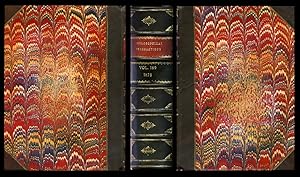About this Item
FIRST EDITION & PRINTING OF JOULE'S FINAL DETERMINATION OF THE MECHANICAL EQUIVALENT OF HEAT. This was the "last experimental research of any magnitude that Joule undertook" (Reynolds, Memoir of James Prescott Joule, 165). Crookes information appears below. Volume includes Parts I & II of the Phil Trans bound together and 70 plates. Inspired by his belief that heat was derived from work, Joule spent a great deal of his life converting mechanical work directly into heat without any electrical steps as he worked to determine the mechanical equivalent of heat. The concept of the mechanical equivalent of heat states "that motion and heat are mutually interchangeable and that in every case, a given amount of work would generate the same amount of heat, provided the work done is totally converted to heat energy" (Wikipedia). In this paper, Joule discusses problems relating to his discovery of the first law of thermodynamics, the principle of the conservation of energy, and presents his final measurement of the mechanical equivalent of heat. His final measurement of the mechanical equivalent of heat was 772.55, a number Joule also requested be engraved on his gravestone. The result of Joule's final experiments by the direct method of friction presented in this paper agreed almost exactly with the value he had found in 1850. "It appeared, therefore, that the cause of the discrepancy lay in the unit of resistance. Any doubt as to this was soon resolved, for Rowland, in the same year as Joule's last paper was published. showed that the standard of resistance was about 1 per cent smaller than the committee of 1864 had intended it to be, and that, making this correction, the results of his own experiments by the methods of friction and of electrical heating agreed very closely both among themselves and also with Joule's value, 772.5. This result was confirmed in 1881 and 1882 by Lord Rayleigh, who found that the value of the British Association unit of resistance was .9867 instead of unity, while the value required to bring Joule's two determinations of J. into complete accordance is .9873. Thus the exactness of his work has been amply verified" (DNB, 30, 216). ALSO: A Bakerian lecture by the British chemist Sir William Crookes here in its first printing. "On the Repulsion Resulting From Radiation. Part V." is a long and important paper in the history of vacuum physics. In it, Crookes "looked at the effect of repulsion due to radiation on chemical precipitates, varied the characteristics of the radiation, investigated conductors and experimented with the presentation of surfaces", comparing the reactions of various substances by using radiometers (Wess, Crookes's Radiometers, Notes and Records of the Royal Society, 2010). Of this paper, James Clerk Maxwell wrote: "Mr. Crookes describes several most extensive series of experiments. The labour, skill and ingenuity displayed in these experiments are marvelous and many of the individual results are valuable but I think the improvement of the methods of making measuring and preserving a vacuum is likely to be still more valuable to science than any of the actual experiments" (Maxwell, The Scientific Letters, 681). And Maxwell was right: Crookes did a great deal of important work, but "he was a pioneer in the construction and use of vacuum tubes for the study of physical phenomena" (Wikipedia). CONDITION & DETAILS: London: Harrison and Sons. Ex-libris bearing a tiny on the title page and a small pencilled notation; no other markings. Full volume, Parts I & II, complete. Quarto. (288 x 213mm). Part I: [4], 12, [318], Part II: [18], 319-826, [4]. 70 plates. Handsomely rebound in aged calf. 5 raised bands at the spine, each gilt-ruled; gilt-tooled fleur de lis at the spine. Red and black, gilt-lettered spine labels. Tightly bound; new endpapers. Bright and clean throughout (including plates). Occasional and minor small closed tears at the margin. Near fine. Seller Inventory # 872
Contact seller
Report this item
![]()
